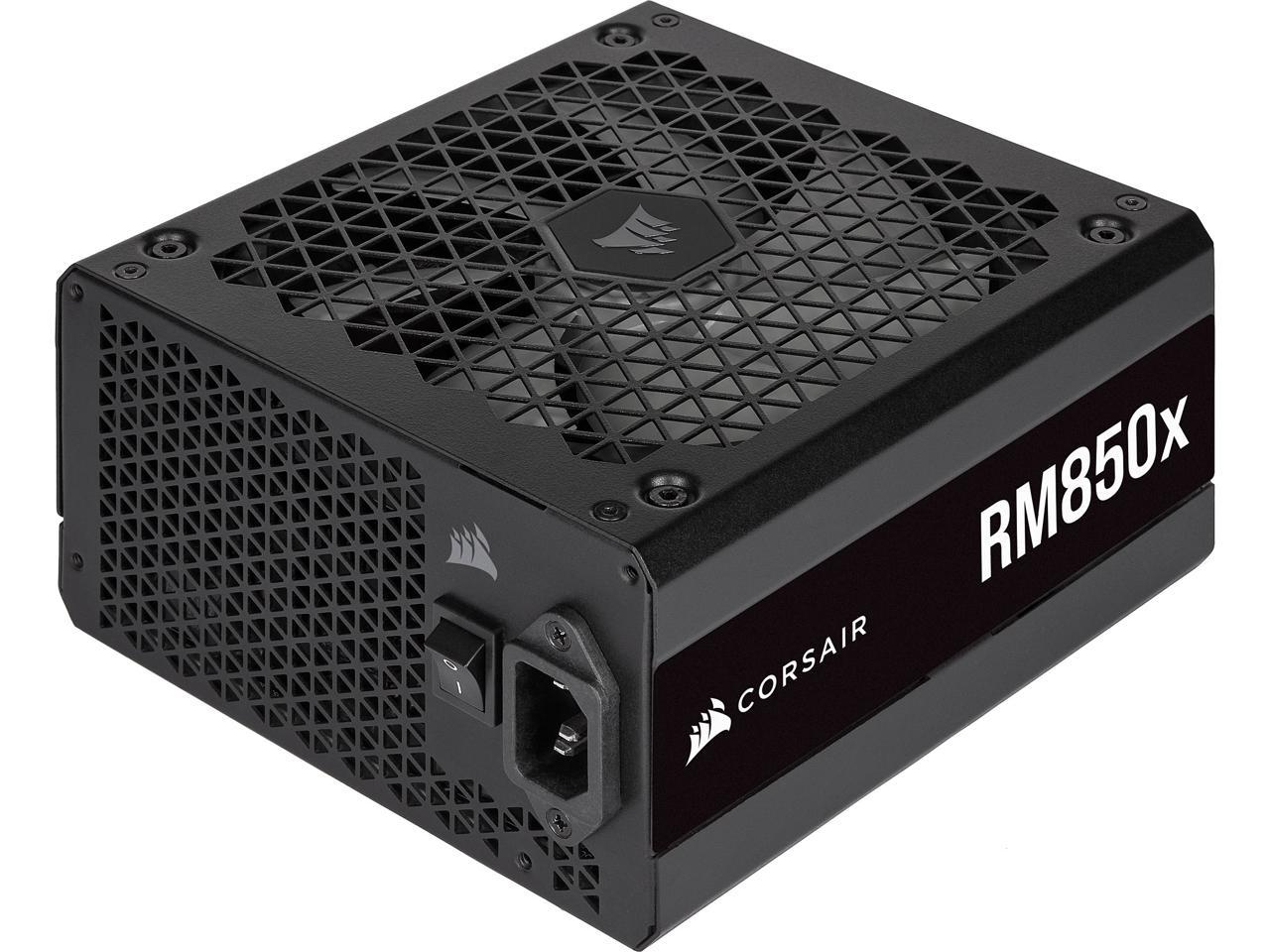Why you can trust Tom's Hardware
To learn more about our PSU tests and methodology, please check out How We Test Power Supply Units.
Primary Rails And 5VSB Load Regulation
The following charts show the main rails' voltage values recorded between a range of 40W up to the PSU's maximum specified load, along with the deviation (in percentages). Tight regulation is an important consideration every time we review a power supply because it facilitates constant voltage levels despite varying loads. Tight load regulation also, among other factors, improves the system’s stability, especially under overclocked conditions and, at the same time, it applies less stress to the DC-DC converters that many system components utilize.

Results 1-8: Load Regulation


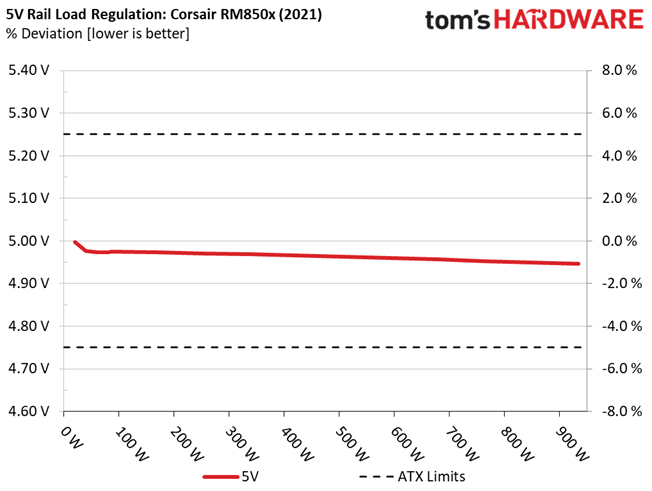


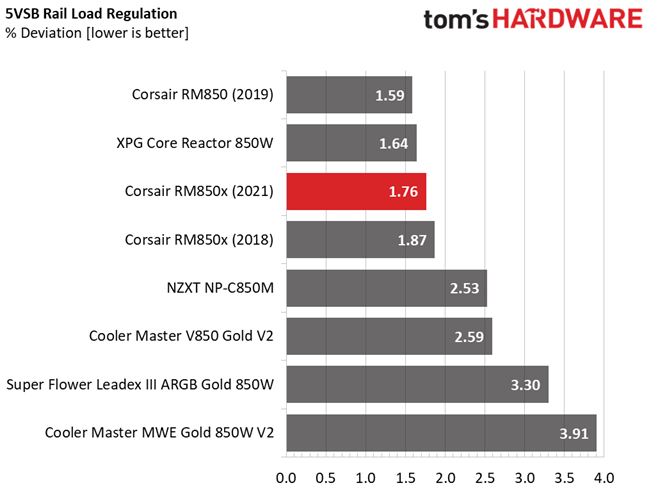

Load regulation is tight on all rails. It would be even tighter at 12V, if it wasn't for a voltage increase on this rail, at light loads.
Hold-Up Time
Put simply; hold-up time is the amount of time that the system can continue to run without shutting down or rebooting during a power interruption.

Results 9-12: Hold-Up Time



The hold-up time is pretty long and the power ok signal is accurate.
Inrush Current
Inrush current, or switch-on surge, refers to the maximum, instantaneous input current drawn by an electrical device when it is first turned on. A large enough inrush current can cause circuit breakers and fuses to trip. It can also damage switches, relays, and bridge rectifiers. As a result, the lower the inrush current of a PSU right as it is turned on, the better.

Results 13-14: Inrush Current
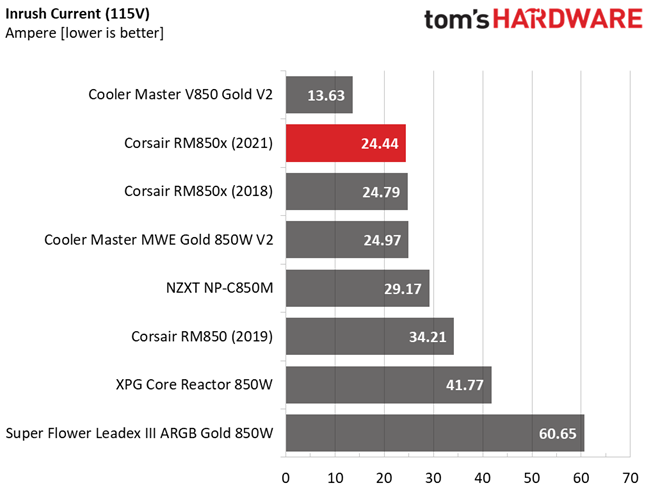
Inrush Currents are low, with both voltage inputs.
Leakage Current
In layman's terms, leakage current is the unwanted transfer of energy from one circuit to another. In power supplies, it is the current flowing from the primary side to the ground or the chassis, which in the majority of cases is connected to the ground. For measuring leakage current, we use a GW Instek GPT-9904 electrical safety tester instrument.
The leakage current test is conducted at 110% of the DUT's rated voltage input (so for a 230-240V device, we should conduct the test with 253-264V input). The maximum acceptable limit of a leakage current is 3.5 mA and it is defined by the IEC-60950-1 regulation, ensuring that the current is low and will not harm any person coming in contact with the power supply's chassis.

Although the EMI filter has all required components, including four Y caps, still leakage current is low.
10-110% Load Tests
These tests reveal the PSU's load regulation and efficiency levels under high ambient temperatures. They also show how the fan speed profile behaves under increased operating temperatures.
| Test # | 12V | 5V | 3.3V | 5VSB | DC/AC (Watts) | Efficiency | Fan Speed (RPM) | PSU Noise (dB[A]) | Temps (In/Out) | PF/AC Volts |
| 1 | 5.268A | 2.011A | 2.008A | 1.008A | 84.962 | 87.701% | 0 | <6.0 | 44.39°C | 0.978 |
| 12.028V | 4.975V | 3.284V | 4.960V | 96.877 | 40.56°C | 115.13V | ||||
| 2 | 11.575A | 3.016A | 3.016A | 1.211A | 170.033 | 90.790% | 0 | <6.0 | 45.49°C | 0.990 |
| 12.020V | 4.973V | 3.283V | 4.956V | 187.282 | 41.20°C | 115.09V | ||||
| 3 | 18.261A | 3.521A | 3.519A | 1.414A | 255.036 | 91.619% | 0 | <6.0 | 46.63°C | 0.994 |
| 11.992V | 4.971V | 3.281V | 4.951V | 278.366 | 41.83°C | 115.17V | ||||
| 4 | 24.943A | 4.025A | 4.026A | 1.618A | 340.045 | 91.369% | 0 | <6.0 | 47.04°C | 0.992 |
| 11.981V | 4.969V | 3.279V | 4.946V | 372.167 | 41.97°C | 115.11V | ||||
| 5 | 31.285A | 5.035A | 5.036A | 1.821A | 424.987 | 90.704% | 0 | <6.0 | 48.22°C | 0.993 |
| 11.970V | 4.966V | 3.277V | 4.942V | 468.541 | 42.15°C | 115.12V | ||||
| 6 | 37.615A | 6.046A | 6.046A | 2.000A | 509.412 | 89.941% | 504 | 11.3 | 42.68°C | 0.994 |
| 11.956V | 4.963V | 3.276V | 4.937V | 566.383 | 49.54°C | 115.10V | ||||
| 7 | 44.008A | 7.059A | 7.057A | 2.231A | 594.881 | 89.067% | 862 | 26.9 | 43.12°C | 0.995 |
| 11.947V | 4.960V | 3.274V | 4.931V | 667.905 | 50.71°C | 115.16V | ||||
| 8 | 50.391A | 8.002A | 8.070A | 2.437A | 679.893 | 88.075% | 1249 | 37.0 | 44.37°C | 0.996 |
| 11.943V | 4.957V | 3.272V | 4.925V | 771.944 | 52.89°C | 115.12V | ||||
| 9 | 57.204A | 8.582A | 8.562A | 2.438A | 765.180 | 87.150% | 1455 | 41.5 | 44.39°C | 0.997 |
| 11.934V | 4.953V | 3.270V | 4.923V | 878.008 | 53.31°C | 115.15V | ||||
| 10 | 63.782A | 9.092A | 9.084A | 3.058A | 849.951 | 86.139% | 1626 | 44.5 | 45.02°C | 0.997 |
| 11.918V | 4.949V | 3.269V | 4.907V | 986.725 | 54.70°C | 115.15V | ||||
| 11 | 70.942A | 9.099A | 9.095A | 3.059A | 934.774 | 84.932% | 1862 | 48.0 | 46.59°C | 0.997 |
| 11.912V | 4.946V | 3.266V | 4.905V | 1100.620 | 57.16°C | 115.12V | ||||
| CL1 | 0.116A | 18.002A | 17.999A | 0.000A | 149.596 | 82.843% | 680 | 19.5 | 42.28°C | 0.990 |
| 12.027V | 4.960V | 3.273V | 4.999V | 180.577 | 48.68°C | 115.16V | ||||
| CL2 | 70.844A | 1.000A | 0.999A | 1.000A | 858.252 | 86.595% | 1623 | 44.4 | 44.96°C | 0.997 |
| 11.929V | 4.953V | 3.267V | 4.938V | 991.115 | 54.58°C | 115.12V |
The passive operation lasts long, up to 50% load, even at increased operating temperatures. The unit's efficiency drops notably though at high load with higher than 45 degrees Celsius ambient. The fan spins at its full speed only during the overload test, where we push the PSU beyond its limits.
20-80W Load Tests
In the following tests, we measure the PSU's efficiency at loads significantly lower than 10% of its maximum capacity (the lowest load the 80 PLUS standard measures). This is important for representing when a PC is idle with power-saving features turned on.
| Test # | 12V | 5V | 3.3V | 5VSB | DC/AC (Watts) | Efficiency | Fan Speed (RPM) | PSU Noise (dB[A]) | PF/AC Volts |
| 1 | 1.241A | 0.500A | 0.501A | 0.200A | 19.998 | 80.008% | 0 | <6.0 | 0.870 |
| 11.965V | 4.997V | 3.298V | 4.995V | 24.995 | 115.12V | ||||
| 2 | 2.481A | 1.005A | 1.002A | 0.403A | 39.990 | 84.558% | 0 | <6.0 | 0.944 |
| 11.968V | 4.976V | 3.286V | 4.971V | 47.293 | 115.12V | ||||
| 3 | 3.722A | 1.508A | 1.507A | 0.604A | 60.018 | 86.701% | 0 | <6.0 | 0.972 |
| 11.974V | 4.974V | 3.284V | 4.967V | 69.224 | 115.09V | ||||
| 4 | 4.936A | 2.010A | 2.009A | 0.806A | 79.965 | 87.041% | 0 | <6.0 | 0.977 |
| 12.028V | 4.974V | 3.284V | 4.963V | 91.870 | 115.14V |
The efficiency readings in this load range are impressive.
2% or 10W Load Test
Intel plans on raising the ante at efficiency levels under ultra-light loads. So from July 2020, the ATX spec will require 70% and higher efficiency with 115V input. The applied load is only 10W for PSUs with 500W and lower capacities, while for stronger units we dial 2% of their max-rated-capacity.
| Test # | 12V | 5V | 3.3V | 5VSB | DC/AC (Watts) | Efficiency | Fan Speed (RPM) | PSU Noise (dB[A]) | PF/AC Volts |
| 1 | 1.184A | 0.303A | 0.303A | 0.050A | 16.933 | 77.749% | 0 | <6.0 | 0.843 |
| 11.965V | 5.002V | 3.301V | 5.002V | 21.779 | 115.16V |
The PSU achieves high efficiency with 2% load, exceeding by far Intel's 70% limit.
Efficiency & Power Factor
Next, we plotted a chart showing the PSU's efficiency at low loads, and loads from 10 to 110% of its maximum rated capacity. The higher a PSU’s efficiency, the less energy goes wasted, leading to a reduced carbon footprint and lower electricity bills. The same goes for Power Factor.

Results 15-18: Efficiency

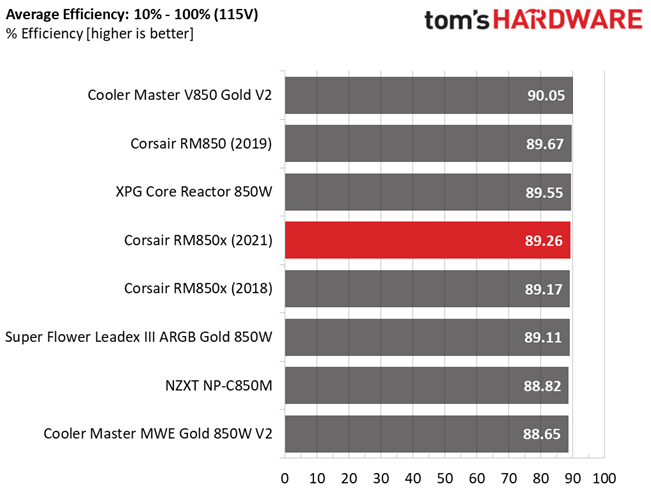



With normal loads the efficiency levels are satisfactory. This platform's strong point is with light and super-light loads, though.
5VSB Efficiency
| Test # | 5VSB | DC/AC (Watts) | Efficiency | PF/AC Volts |
| 1 | 0.100A | 0.507 | 76.471% | 0.067 |
| 5.072V | 0.663 | 115.17V | ||
| 2 | 0.250A | 1.268 | 78.417% | 0.149 |
| 5.069V | 1.617 | 115.17V | ||
| 3 | 0.550A | 2.786 | 79.058% | 0.260 |
| 5.067V | 3.524 | 115.16V | ||
| 4 | 1.000A | 5.055 | 77.961% | 0.346 |
| 5.054V | 6.484 | 115.16V | ||
| 5 | 1.501A | 7.569 | 77.838% | 0.395 |
| 5.044V | 9.724 | 115.16V | ||
| 6 | 3.001A | 15.050 | 76.801% | 0.461 |
| 5.015V | 19.596 | 115.15V |

Results 19-20: 5VSB Efficiency

We would like to see higher efficiency at 5VSB.
Power Consumption In Idle And Standby
| Mode | 12V | 5V | 3.3V | 5VSB | Watts | PF/AC Volts |
| Idle | 11.955V | 5.002V | 3.302V | 5.003V | 2.831 | 0.249 |
| 115.2V | ||||||
| Standby | 0.033 | 0.086 | ||||
| 115.2V |
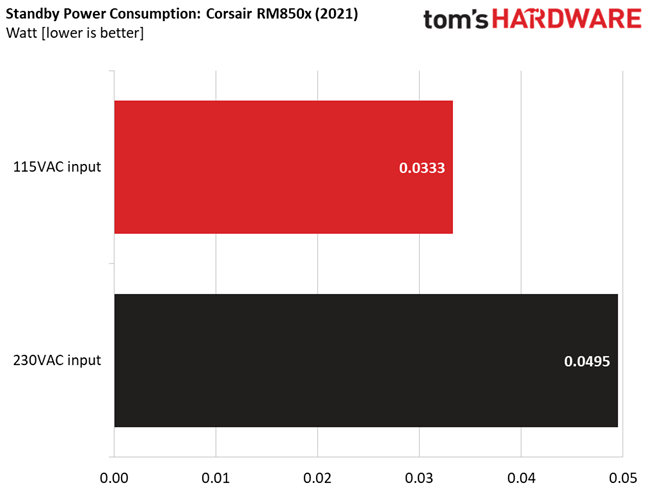
Results 21-22: Vampire Power

The platform's energy needs at standby are minimal.
Fan RPM, Delta Temperature, And Output Noise
All results are obtained between an ambient temperature of 37 to 47 degrees Celsius (98.6 to 116.6 degrees Fahrenheit).


The fan speed profile is not so aggressive, under high operating temperatures.
The following results were obtained at 30 to 32 degrees Celsius (86 to 89.6 degrees Fahrenheit) ambient temperature.


Under normal operating temperatures, the PSU enters the 30-35 dBA region once the load exceeds 600W, and with 50W more, its noise exceeds 35 dBA but doesn't go above 40 dBA.
MORE: Best Power Supplies
MORE: How We Test Power Supplies
MORE: All Power Supply Content
Current page: Load Regulation, Hold-Up Time, Inrush & Leakage Current, Efficiency and Noise
Prev Page Specifications and Part Analysis Next Page Protection Features, DC Power Sequencing, Cross-Load Tests and Infrared Images
Aris Mpitziopoulos is a contributing editor at Tom's Hardware, covering PSUs.
-
Isokolon shame they changed the fan. the 2015 & 2018 RMx were so great for low-noise enthusiasts.Reply
how the review classifies an almost 30db unit as "quiet" is beyond me. -
Udyr What makes this unit better than the Toughpower GF1?Reply
https://www.tomshardware.com/reviews/thermaltake-toughpower-gf1-850w-power-supply -
jsz031 Hi Aris.. like your reviews..Reply
small question. I noticed the Bulk/hold up caps get higher with wattage. can you explain how this impacts a general PSU?
for example/off topic, I have a 5 year old 550w G2 and it has a 400v 470uf cap. Just purchased a 550w g3 and the cap is lower capacity @ 400v 390uf.
Does this mean anything or am I overthinking it? is the 550w g2 better than "base" spec? I understand leakage can occur over time, I'm just not sure if its a downgrade or upgrade in specific areas.
thank you. -
jayjr1105 Reply
As long as they are meeting the ATX spec of 17ms hold up time, it doesn't really matter. The G2 was probably overkill so they cut costs by going with a lower capacity one.jsz031 said:Hi Aris.. like your reviews..
small question. I noticed the Bulk/hold up caps get higher with wattage. can you explain how this impacts a general PSU?
for example/off topic, I have a 5 year old 550w G2 and it has a 400v 470uf cap. Just purchased a 550w g3 and the cap is lower capacity @ 400v 390uf.
Does this mean anything or am I overthinking it? is the 550w g2 better than "base" spec? I understand leakage can occur over time, I'm just not sure if its a downgrade or upgrade in specific areas.
thank you. -
tomkawal Reply
..and worst quality coming from production line! Mine was covered with thick layer of metal salts from soldering. It stopped turning on. Works again after thorough cleanup.Admin said:The new Corsair RM850x is among the best PSUs in its category.
Corsair RM850x (2021) Power Supply Review : Read more -
tomkawal Beautifully presented. I was not so lucky with the unit I got, which stopped working after a month. Sent back to eBuyer guys and received it again not fixed (generally they requested ALL cables where I wanted only brick swap - this is totally unacceptable for me when the wires are in place tied to enclosure!) Raised ticket with Corsair with no answer in 2 days. Fixed on my own with one hour of cleaning the PCB from thick layer of soldering flux on the bottom side of PCB which caused leakage currents all over the board. Now it works. Horrendous experience and I don't recommend none of these businesses.Reply

